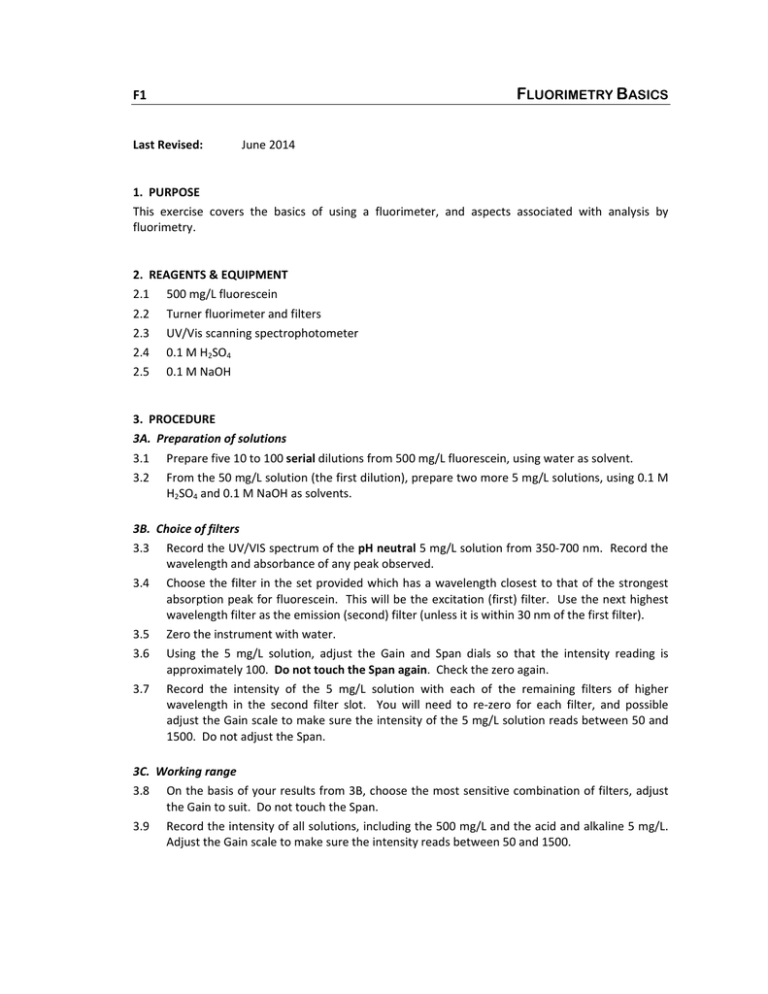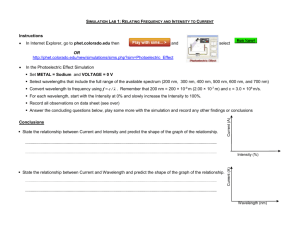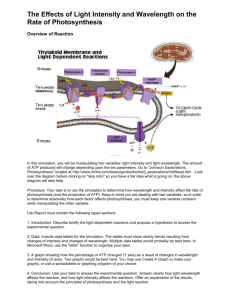F B F1
advertisement

F1 FLUORIMETRY BASICS Last Revised: June 2014 1. PURPOSE This exercise covers the basics of using a fluorimeter, and aspects associated with analysis by fluorimetry. 2. REAGENTS & EQUIPMENT 2.1 500 mg/L fluorescein 2.2 Turner fluorimeter and filters 2.3 UV/Vis scanning spectrophotometer 2.4 0.1 M H2SO4 2.5 0.1 M NaOH 3. PROCEDURE 3A. Preparation of solutions 3.1 Prepare five 10 to 100 serial dilutions from 500 mg/L fluorescein, using water as solvent. 3.2 From the 50 mg/L solution (the first dilution), prepare two more 5 mg/L solutions, using 0.1 M H2SO4 and 0.1 M NaOH as solvents. 3B. Choice of filters 3.3 Record the UV/VIS spectrum of the pH neutral 5 mg/L solution from 350‐700 nm. Record the wavelength and absorbance of any peak observed. 3.4 Choose the filter in the set provided which has a wavelength closest to that of the strongest absorption peak for fluorescein. This will be the excitation (first) filter. Use the next highest wavelength filter as the emission (second) filter (unless it is within 30 nm of the first filter). 3.5 Zero the instrument with water. 3.6 Using the 5 mg/L solution, adjust the Gain and Span dials so that the intensity reading is approximately 100. Do not touch the Span again. Check the zero again. 3.7 Record the intensity of the 5 mg/L solution with each of the remaining filters of higher wavelength in the second filter slot. You will need to re‐zero for each filter, and possible adjust the Gain scale to make sure the intensity of the 5 mg/L solution reads between 50 and 1500. Do not adjust the Span. 3C. Working range 3.8 On the basis of your results from 3B, choose the most sensitive combination of filters, adjust the Gain to suit. Do not touch the Span. 3.9 Record the intensity of all solutions, including the 500 mg/L and the acid and alkaline 5 mg/L. Adjust the Gain scale to make sure the intensity reads between 50 and 1500. 4. REPORT Calculations for all results in 3B & 3C, correct the intensity for gain scale variations by dividing the measured intensity by the Gain scale value for the results in 3B, plot corrected intensity against wavelength of emission filter for the results in 3C except the acid and alkaline 5 mg/L solutions, plot corrected intensity against concentration – you will need to plot the graph using a log‐log scale (in Excel, this can be done in Format axis) from the absorbance value determined in step 3.3, calculation the concentration that would give an absorbance of 0.1 Discussion explain the shape of the graph from 3B explain the shape of the graph from 3C estimate the linear response region from your graph of 3C results identify the concentration beyond which self‐quenching occurs using the structure of fluorescein, explain why it is fluorescent explain the effect of pH on fluorescein’s intensity compare the sensitivities of fluorescence and UV/VIS for fluorescein, based on your results (use the concentration giving an absorbance of 0.1 in UV/VIS and the low end of the linear region in fluorescence as your comparison) Questions 1. Outline the use of fluorescein in tracer studies of water system. 2. 3. F1 Explain why samples for analysis of fluorescein content would need to be buffered before measurement. What colour is fluorescein under normal lighting? Under UV light? Explain the difference. p2 F1. FLUORIMETRY BASICS RESULTS SHEET Maximum absorbance Wavelength at max. A 2nd Filter Intensity Gain Solution (mg/L) Intensity Gain 500 50 5 neutral 5 acid 5 alkaline 0.5 0.05 0.005




